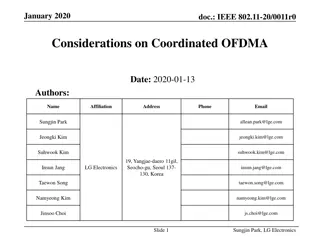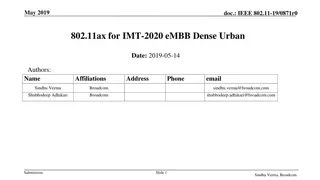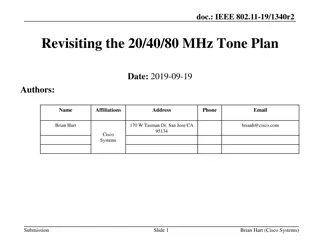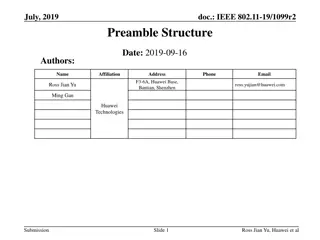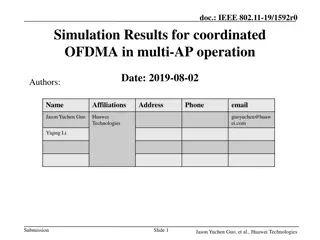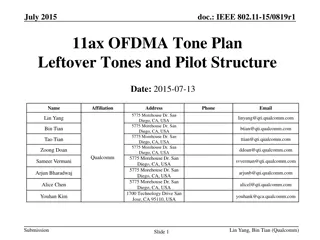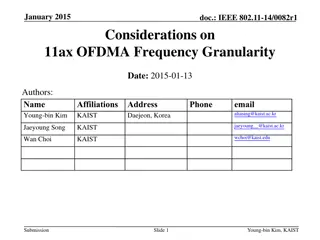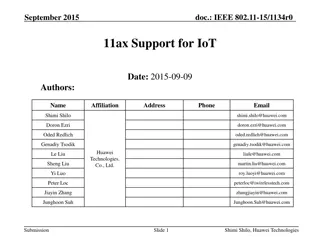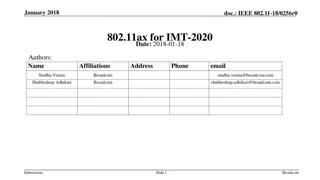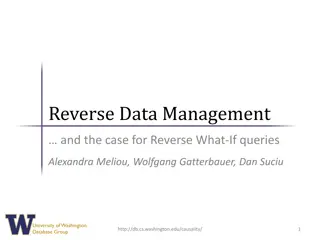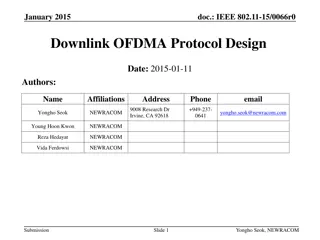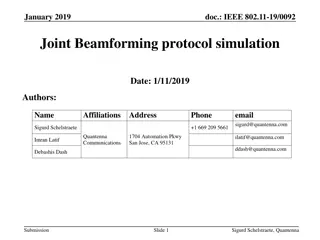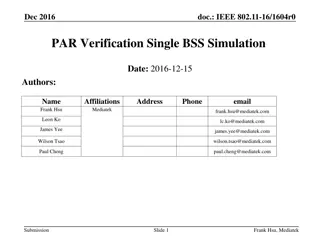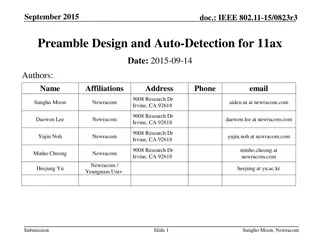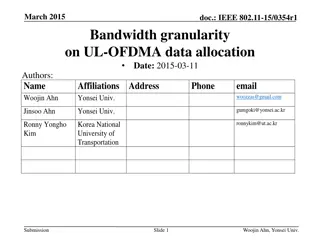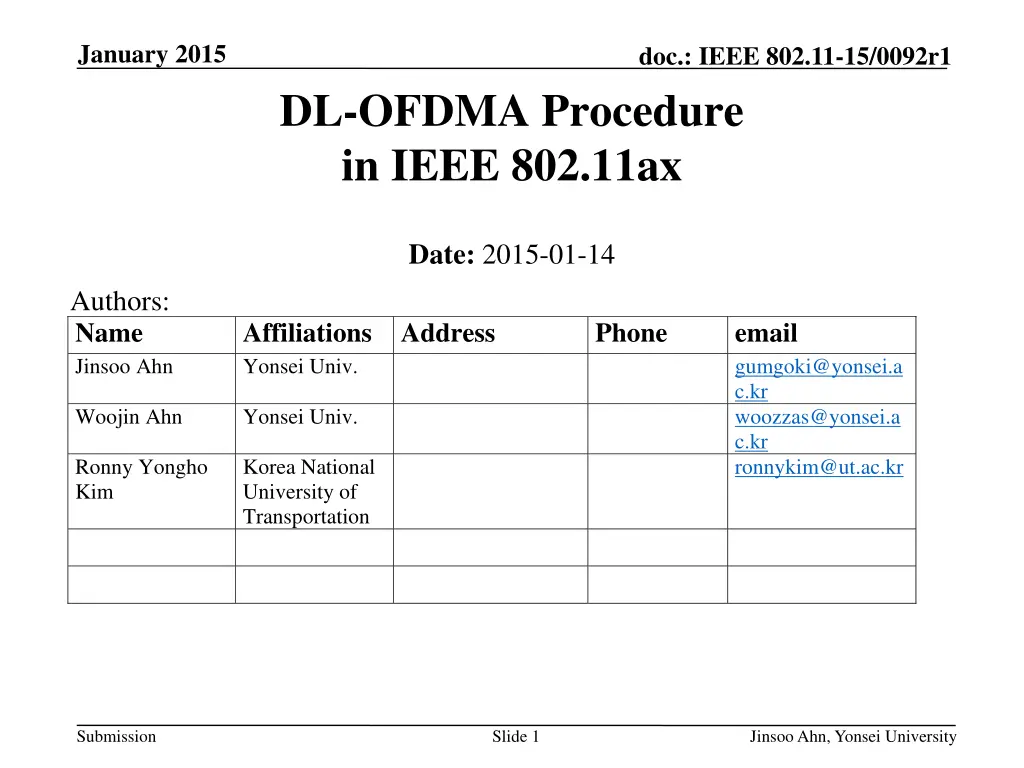
Enhancing WLAN Efficiency with IEEE 802.11ax OFDMA Procedure
Achieve high efficiency in IEEE 802.11ax WLAN by optimizing spectrum resource utilization through DL-OFDMA procedures, multiuser diversity, UL-MU-MIMO, and new channel access patterns. Explore sub-band based OFDMA, APCH allocation methods, and resource utilization comparisons for enhanced performance in dense environments.
Download Presentation

Please find below an Image/Link to download the presentation.
The content on the website is provided AS IS for your information and personal use only. It may not be sold, licensed, or shared on other websites without obtaining consent from the author. If you encounter any issues during the download, it is possible that the publisher has removed the file from their server.
You are allowed to download the files provided on this website for personal or commercial use, subject to the condition that they are used lawfully. All files are the property of their respective owners.
The content on the website is provided AS IS for your information and personal use only. It may not be sold, licensed, or shared on other websites without obtaining consent from the author.
E N D
Presentation Transcript
January 2015 doc.: IEEE 802.11-15/0092r1 DL-OFDMA Procedure in IEEE 802.11ax Date: 2015-01-14 Authors: Name Jinsoo Ahn Affiliations Address Yonsei Univ. Phone email gumgoki@yonsei.a c.kr woozzas@yonsei.a c.kr ronnykim@ut.ac.kr Woojin Ahn Yonsei Univ. Ronny Yongho Kim Korea National University of Transportation Submission Slide 1 JinsooAhn, Yonsei University
January 2015 doc.: IEEE 802.11-15/0092r1 Background Achieving High Efficient WLAN In IEEE 802.11ax PAR [1], IEEE 802.11ax should provide methods for efficient use of spectrum resources in dense STAs per BSS. Make more efficient use of spectrum resources in scenarios with a high density of STAs per BSS. Significantly increase spectral frequency reuse and manage interference between neighboring overlapping BSS (OBSS) in scenarios with a high density of both STAs and BSSs. Efficient use of spectrum resource Using Multiuser Diversity OFDMA, UL-MU-MIMO Increasing spectral frequency reuse and manage interference between neighboring overlapping BSS (OBSS) New Channel usage pattern under dense OBSS scenario APCH based channel access[2] Submission Slide 2 JinsooAhn, Yonsei University
January 2015 doc.: IEEE 802.11-15/0092r1 OFDMA 20MHz band based OFDMA and smaller band based OFDMA could be considered New preamble and frame structure for sub-band based OFDMA OFDMA Procedure Without RTS/CTS[3] New preamble and header include channel-user assignment information Full scanning is needed for different header on wider band operation Heavy header for Conventional primary channel based scanning With RTS/CTS[4] Conventional RTS could not provide channel-user assignment information Channel-user assignment frame or New type of RTS should be used ACK or CTS[4] Multiuser ACK or CTS method need to be provided Submission Slide 3 JinsooAhn, Yonsei University
January 2015 Alternative Primary Channel(APCH) based OFDMA doc.: IEEE 802.11-15/0092r1 APCH is a new basis channel of channel expansion[2] 11ax Control frames could be transmitted via APCH Reducing 11ax Control Frame overhead Control frames for APCH operation are transmitted via Conventional Primary Channel APCH could be allocated statically or dynamically Dynamic allocation could enhance performance but need more complexity History based allocation, inter AP management based allocation Submission Slide 4 JinsooAhn, Yonsei University
January 2015 doc.: IEEE 802.11-15/0092r1 APCH based OFDMA Resource utilization comparison[2] CH1 is Primary Channel CH3 is APCH Channel (Colored means busy) Legacy All available CH APCH CH1 CH2 CH3 CH4 CH1 CH2 CH3 CH4 CH1 CH2 CH3 CH4 CH1 CH2 CH3 CH4 Case1 Busy Case2 Busy Case3 Busy Case4 Busy Busy Case5 Busy Busy Case6 Busy Submission Slide 5 JinsooAhn, Yonsei University
January 2015 doc.: IEEE 802.11-15/0092r1 APCH based OFDMA Channel usage vs busy channel prob. ??(??=0.7)[2] 160 With Primary Legacy Without Primary Using Available Channel 140 120 100 Average Bandwidth 80 69% 60 39% 108% 40 52% 119% 39% 20 0 0 0.1 0.2 0.3 Busy Probability of each Secondary Channel 0.4 0.5 0.6 0.7 0.8 0.9 1 Submission Slide 6 JinsooAhn, Yonsei University
January 2015 doc.: IEEE 802.11-15/0092r1 APCH based OFDMA vs All available channel based OFDMA All available channel access allows target AP to utilize full available channel just at that time All available channel access sustaining primary channel based back-off might degrade OBSS channel usage and frequency reuse Throughput/AREA might be degraded # of APCH is a factor of channel access aggressiveness all available channel based OFDMA = set all channels as APCH(# of APCH == # of capable channels) Submission Slide 7 JinsooAhn, Yonsei University
January 2015 doc.: IEEE 802.11-15/0092r1 APCH based OFDMA RTS/CTS procedure RTS/CTS exchange could initiate OFDMA transmission[4] Protection will prevent Multiuser TX failure but it is hard to protect transmission duration because of multiple points in OFDMA[4] Channel-user assignment information(Resource Allocation, RA) need to be provided during RTS/CTS phase RTS RA MU-CTS Data MU-ACK Assumption Each STA could listen its Primary Channel and APCH Multiuser and Wideband TX failure is more costly than protection overhead # of users or TXOP length might affect RTS/CTS threshold Submission Slide 8 JinsooAhn, Yonsei University
January 2015 doc.: IEEE 802.11-15/0092r1 APCH based OFDMA RTS/CTS procedure concept Preamble Resource Allocation for Primary channel based band Data (Using <20MHz band) Primary Channel MU-CTS MU-ACK RTS-to-self Secondary channel #1 Busy Resource Allocation for APCH based band CTS1 ACK1 Secondary channel #2 APCH RTS-to-self Data Resource Allocation for APCH based band CTS2 ACK2 RTS-to-self Data Secondary channel #3 Submission Slide 9 JinsooAhn, Yonsei University
January 2015 doc.: IEEE 802.11-15/0092r1 APCH based OFDMA Procedure RTS-to-Self Using Legacy RTS frame format Transmitter Address(TA) = Receiver Address(RA) Multi-user session initiator frame 11ax STA is ready to receive resource allocation Legacy STAs recognize it as a RTS frame and set NAV Resource Allocation(RA) New control frame to support OFDMA STA-Channel information Different RA frames are transmitted between Primary channel and APCH (Reducing RA overhead) Submission Slide 10 JinsooAhn, Yonsei University
January 2015 doc.: IEEE 802.11-15/0092r1 APCH based OFDMA Procedure Resource Allocation(RA) Since RI Frame is transmitted right after RTS, NAV setting will be sustained A STA which receive RTS could be reset its NAV if no PHY- RXSTART.indication primitive is detected from the PHY during (2 aSIFSTime) + (CTS_Time) + aPHY-RX-START-Delay + (2 aSlotTime)[5] MU-CTS & MU-ACK CTS and ACK for supporting Multiuser session Following slides show some possible solutions Submission Slide 11 JinsooAhn, Yonsei University
January 2015 doc.: IEEE 802.11-15/0092r1 APCH based OFDMA Procedure Cascade CTS/ACK Method Preamble Resource Allocation for Primary channel based band Data (Using <20MHz band) ACK3.1 ACK3.2 ACK3.3 ACK3.4 RTS-to-self CTS3.1 CTS3.2 CTS3.3 CTS3.4 Primary Channel Busy Secondary channel #1 Resource Allocation for APCH based band ACK1 RTS-to-self CTS1 Data Secondary channel #2 APCH Resource Allocation for APCH based band ACK2 CTS2 RTS-to-self Data Secondary channel #3 CTS and ACK overhead increases as the number of sub-band STAs increases Submission Slide 12 JinsooAhn, Yonsei University
January 2015 doc.: IEEE 802.11-15/0092r1 APCH based OFDMA Procedure Cascade CTS/ACK Method with Fast ACK Preamble Resource Allocation for Primary channel based band Data (Using <20MHz band) Fast ACK3.1 Fast ACK3.2 Fast ACK3.3 (Fast) ACK3.4 RTS-to-self CTS3.1 CTS3.2 CTS3.3 CTS3.4 Primary Channel Busy Secondary channel #1 Resource Allocation for APCH based band ACK1 RTS-to-self CTS1 Data Secondary channel #2 APCH Resource Allocation for APCH based band ACK2 CTS2 RTS-to-self Data Secondary channel #3 CTS and ACK overhead increases as the number of sub-band STAs increases(Relatively lower than without Fast ACK case) Last Fast ACK could be replaced by Legacy ACK to announce TXOP termination Submission Slide 13 JinsooAhn, Yonsei University
January 2015 doc.: IEEE 802.11-15/0092r1 APCH based OFDMA Procedure Cascade CTS/ACK Each STA within the Resource Allocation Frame sends CTS frame sequentially Using conventional CTS and ACK Fast ACK Fast ACK may not have legacy preamble, only have HEW preamble Shorter air time than Conventional ACK Fast ACK may not provide any information to legacy STAs Submission Slide 14 JinsooAhn, Yonsei University
January 2015 doc.: IEEE 802.11-15/0092r1 APCH based OFDMA Procedure Sub-band CTS/ACK Method Resource Allocation for Primary channel Primary Channel CTS 3.1 CTS 3.2 CTS 3.3 CTS 3.4 ACK 3.1 ACK 3.2 ACK 3.3 ACK 3.4 Preamble Data (Using <20MHz band) CTS3 ACK3 (Common) RTS-to-self based band (Common) Busy Secondary channel #1 Resource Allocation for APCH based band RTS-to-self CTS1 ACK1 Data Secondary channel #2 APCH Resource Allocation for APCH based band CTS2 ACK2 RTS-to-self Data Secondary channel #3 CTS overhead have only 2 variations, with Sub-band TX case or not Common CTS is transmitted by STAs which have transmitted sub-band CTS Submission Slide 15 JinsooAhn, Yonsei University
January 2015 doc.: IEEE 802.11-15/0092r1 APCH based OFDMA Procedure Sub-band CTS and ACK STAs transmit its CTS via sub-band indicated from RA STAs transmit its ACK via sub-band which they receive DATA from Common CTS and ACK Legacy form of CTS and ACK Base rate and identical frames Transmitted from STAs that participate in OFDMA sub-band transmission Provide legacy protection and Legacy NAV update (Early TXOP termination by ACK) Common ACK could be eliminated unless Early TXOP termination might be supported Submission Slide 16 JinsooAhn, Yonsei University
January 2015 doc.: IEEE 802.11-15/0092r1 Conclusions APCH based OFDMA was presented Protection for Multiuser and Wideband operation RTS-to-Self as a OFDMA session initiator Resource Allocation frame is needed Mechanisms for OFDMA RTS/CTS RTS RA CTS DATA ACK structure in order to maximize commonality with the legacy procedure Common CTS, common ACK in order to provide NAV operation We need to discuss about Adopting RA frame for OFDMA Submission Slide 17 JinsooAhn, Yonsei University
January 2015 doc.: IEEE 802.11-15/0092r1 Straw Poll 1 Do you agree to add to the TG Specification Framework: 4.y.z DL OFDMA shall support both basic transmission (without RTS/CTS) and RTS/CTS based transmission. Y N ABS Submission Slide 18 JinsooAhn, Yonsei University
January 2015 doc.: IEEE 802.11-15/0092r1 Straw Poll 2 Do you agree to add to the TG Specification Framework: 4.y.z DL OFDMA shall transmit STAs resource allocation information through all allocated channels. Y N ABS Submission Slide 19 JinsooAhn, Yonsei University
January 2015 doc.: IEEE 802.11-15/0092r1 Straw Poll 3 Do you agree to add to the TG Specification Framework: 4.y.z DL OFDMA shall provide NAV setting mechanism for allocated channels. Y N ABS Submission Slide 20 JinsooAhn, Yonsei University
January 2015 doc.: IEEE 802.11-15/0092r1 Straw Poll 4 Do you agree to add to the TG Specification Framework: 4.y.z DL OFDMA shall utilize idle channels without utilizing primary channel. Y N ABS Submission Slide 21 JinsooAhn, Yonsei University
January 2015 doc.: IEEE 802.11-15/0092r1 Reference [1] IEEE 802.11-14/0165r1 802.11 HEW SG Proposed PAR [2] IEEE 802.11-14/1437r1 Efficient Wider Bandwidth Operation in IEEE 802.11ax [3] IEEE 802.11-14/1210r1 HEW PPDU Format for Supporting MIMO-OFDMA [4] IEEE 802.11-14/1431r1 Issues on UL-OFDMA Transmission [5] IEEE802.11-2012 section 9.3.2.4 Submission Slide 22 JinsooAhn, Yonsei University

